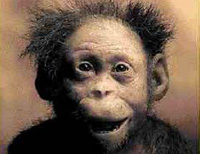Bones of Little Lucy to unveil origin of man
At the end of September palaeoanthropologists made the biggest step forwards since the previous discovery of the world’s most ancient young woman Lucy, who was found 32 years ago. Now scientists finally finished cleaning up and examining in detail an almost complete skeleton of a new three-year-old girl discovered in the Dikika area in Ethiopia back in 2000.

This Ethiopian girl who appears to be humanity’s ancestor is an Australopithecus Afarensis. Her name is Selam, which means “for peace” in North Ethiopian dialect, she is a few hundred thousand years older than Lucy and is currently the oldest hominid in the world.
As for her anatomic structure Selam is somewhere between the first humans and the proto-human monkeys. She was able to walk on her two legs but she still possessed a hyoid bone under her tongue – an element absent from all species after the Neanderthals. This bone affects the ability to recreate sounds and is crucial in the development of the human speech.
Ethiopian scientist Zeresenay Alemseged, one of the expedition’s members who discovered the skull, the limbs and the torso of the girl, considers the remains to be of utmost importance: “The large amount of bones, their age as well is the age of Selam herself became a unique precedent in the history of palaeoathropology and opened up new opportunities in human ancestry research. Other researchers support Alemseged’s opinion, among them Donald Yohansen, a man who discovered Lucy in the same area over three decades ago (and named her thus after listening to Beatles song “Lucy in the sky with diamonds.”) He called Selam’s discovery unprecedented in terms of skeleton’s completeness.
Alemseged added that the toddler Selam (as opposed to Lucy) was found with her fingers, leg and torso bones, and – what’s most significant – a full skull, which enabled the scientists to recreate the girl’s face. She is also known as “Little Lucy” and she will also shine the diamond light from above onto the reconstructive history of human origins.
Pravda.ru
Translated by Natalia Vysotskaya
Subscribe to Pravda.Ru Telegram channel, Facebook, RSS!


